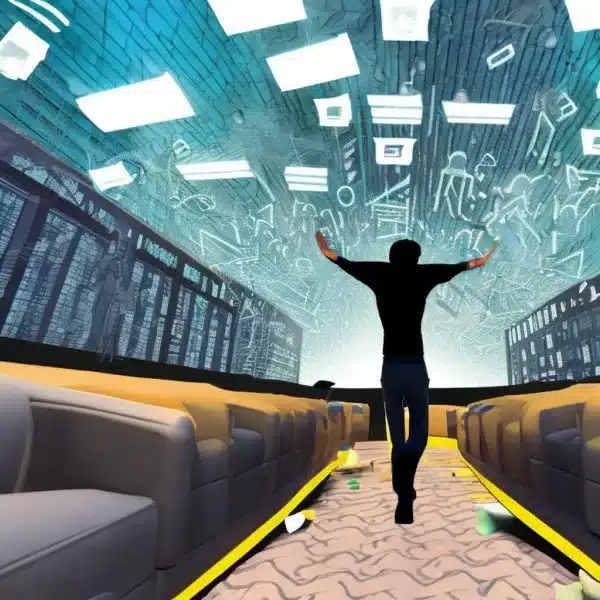|
Getting your Trinity Audio player ready...
|

The Physical World And The Virtual World
Table of Contents
What is the concept of the virtual world?
The concept of a virtual world refers to a computer-generated, immersive, and interactive environment that simulates reality or an imaginary world. Virtual worlds are typically created using computer technology, and they can range from simple 2D environments to complex 3D simulations. These environments can be accessed and interacted with by users, often through the use of digital avatars or characters. Here are some key aspects of virtual worlds:
– Immersion: Virtual worlds aim to immerse users in a digital environment that feels as if they are physically present within it. This immersion can be achieved through the use of 3D graphics, realistic audio, and sometimes even haptic feedback (sensations like touch or force feedback).
– Interactivity: Users can typically interact with objects, other users, and the environment itself within a virtual world. This interaction can include actions like moving, chatting, building, trading, or engaging in various activities, depending on the specific virtual world.
– Persistence: Virtual worlds often exist independently of individual user sessions. Changes made by users, such as constructing buildings or leaving virtual items, are usually persistent and remain in the world even after the user logs out. This persistence allows for the creation of dynamic, evolving virtual environments.
– Social Interaction: Many virtual worlds emphasize social interaction, enabling users to communicate and collaborate with others in the digital space. Virtual worlds can serve as platforms for socializing, gaming, learning, or even conducting business.
– Variety of Applications: Virtual worlds have a wide range of applications, including online gaming (e.g., World of Warcraft), virtual classrooms, virtual reality simulations for training and education, virtual conferences and events, and even virtual marketplaces for buying and selling virtual goods.
– Platforms: Virtual worlds can be accessed through various platforms, including desktop and laptop computers, gaming consoles, virtual reality headsets, and mobile devices. The choice of platform can influence the level of immersion and interactivity available to users.
– Design and Development: Creating virtual worlds involves a combination of computer graphics, programming, and creative design. Game developers, virtual reality companies, and software engineers often work together to bring these digital environments to life.
It’s worth noting that the concept of virtual worlds has evolved over the years, and newer technologies like augmented reality (AR) have expanded the possibilities for blending virtual and physical environments. Virtual worlds continue to be a dynamic and evolving field with applications in entertainment, education, training, and more.
Many people live in both the physical world and engage with virtual worlds simultaneously.
It has become increasingly common for individuals to integrate virtual experiences into their daily lives while maintaining their engagement with the physical world. This balance allows them to derive value and meaning from both realms.
In this context, individuals might spend time in virtual worlds for entertainment, socializing, learning, or creative pursuits. They might play video games, participate in virtual communities, explore virtual reality simulations, or engage in online collaborations. These experiences can offer a range of benefits, such as opportunities for self-expression, skill development, and connection with others who share similar interests.
At the same time, individuals also recognize the importance of their physical existence and the experiences it offers. They engage in face-to-face interactions, pursue real-world activities, take part in physical adventures, and contribute to their communities. They appreciate the tangible aspects of life, the sensory experiences, and the deeper connections that physical presence can provide.
Balancing both the physical and virtual worlds requires individuals to be mindful of their time and energy allocation, ensuring that they maintain a healthy and fulfilling lifestyle. It is crucial to prioritize real-world relationships, responsibilities, and personal well-being while also enjoying the benefits that virtual worlds can offer.
Similarities in the real world and the virtual world
While the real world and the virtual world are distinct in many ways, there are also several similarities between the two:
– Social Interactions: Both the real world and the virtual world offer opportunities for social interaction. People can connect with others, form relationships, and communicate through various means, whether it’s face-to-face interactions in the physical world or through virtual platforms, online communities, and social networks in the virtual world.
– Emotional Experiences: Emotions are a fundamental part of human existence, and they can be experienced in both the real and virtual worlds. Whether it’s joy, sadness, excitement, or empathy, people can have emotional responses to events, interactions, and experiences, regardless of whether they occur in physical reality or within a virtual environment.
– Learning and Skill Development: Both the real and virtual worlds can provide opportunities for learning and skill development. In the physical world, people acquire knowledge through education, training, and hands-on experiences. Similarly, in virtual environments, individuals can engage in educational simulations, virtual training programs, and skill-based games to acquire new knowledge and develop specific abilities.
– Creative Expression: The real and virtual worlds offer avenues for creative expression. In the physical world, people can engage in various artistic endeavors, such as painting, writing, or performing. In the virtual world, individuals can create digital art, compose music, design virtual spaces, or participate in virtual performances, allowing for unique forms of creative expression.
– Exploration and Adventure: Both realms provide opportunities for exploration and adventure. In the physical world, people can travel to new places, embark on outdoor activities, and engage in real-life adventures. Virtual worlds offer virtual travel experiences, immersive gaming environments, and simulations that enable users to explore fantastical realms and engage in virtual adventures.
– Economic and Commercial Activities: The real and virtual worlds are intertwined when it comes to economic and commercial activities. In the physical world, people engage in traditional commerce, businesses, and financial transactions. In the virtual world, there is a growing virtual economy, where individuals can buy and sell virtual goods, engage in virtual currency exchanges, and participate in virtual marketplaces.
Ultimately, living in both the physical and virtual worlds can provide diverse experiences, opportunities, and sources of meaning, and it’s important to recognize that while there are similarities between the real and virtual worlds, they also have distinct characteristics and unique aspects. Understanding and navigating the differences and similarities can help individuals make informed decisions about how they engage with both realms and find a balance that aligns with their values and goals.

The Virtual World And Online Work From Home
The virtual world and online work-from-home arrangements have become increasingly prevalent and important in recent years, especially in light of the COVID-19 pandemic. This transformation has had a profound impact on various aspects of work, business, and daily life. Let’s explore some key points related to the virtual world and working from home:
– Remote Work Trends: The COVID-19 pandemic accelerated the adoption of remote work, making it a common practice in many industries. Companies worldwide have embraced virtual work as a means to ensure business continuity and employee safety.
– Technological Advancements: Advances in technology, including high-speed internet access, cloud computing, collaboration tools, and video conferencing platforms like Zoom and Microsoft Teams, have enabled remote work to thrive. These tools facilitate communication and collaboration among remote teams.
– Flexible Work Arrangements: Virtual work allows for greater flexibility in work arrangements. Employees can often choose their work hours, leading to improved work-life balance. This flexibility is attractive to many professionals.
– Cost Savings: Both employers and employees can benefit from cost savings associated with remote work. Companies can reduce overhead costs by downsizing office space, while employees save money on commuting and related expenses.
– Global Talent Pool: Remote work opens up a global talent pool. Companies can hire the best talent regardless of their location, leading to a more diverse and skilled workforce.
– Challenges: Despite its advantages, remote work also presents challenges. These include feelings of isolation, difficulties in separating work from personal life, and potential security concerns related to remote access to company systems and data.
– Virtual Meetings and Collaboration: Virtual meetings have become the norm for team communication and collaboration. Tools like Slack, Microsoft Teams, and Trello facilitate project management and communication among remote teams.
– Mental Health: Remote work can impact mental health. The lack of social interaction and the blurring of boundaries between work and personal life can lead to burnout and stress. Employers are increasingly focusing on employee well-being and mental health support.
– Cybersecurity: With remote work, the need for robust cybersecurity measures has grown. Companies must secure their networks and educate employees about best practices to protect sensitive data.
– Hybrid Work Models: Some companies have adopted hybrid work models, where employees split their time between working in the office and working remotely. This approach seeks to combine the benefits of both in-person and virtual work.
– Digital Nomadism: The rise of remote work has given rise to the concept of digital nomadism, where individuals work from various locations around the world. This lifestyle is made possible by the ability to work online.
– Legislation and Regulations: Governments and regulatory bodies are adapting to the changing work landscape by implementing new laws and regulations related to remote work, taxes, and labor rights.
In conclusion, the virtual world and online work-from-home arrangements have reshaped the way we work and interact in the modern era. While they offer numerous benefits, they also come with their own set of challenges that both individuals and organizations need to address effectively to ensure a productive and sustainable work environment. The future of work is likely to continue evolving, with a focus on finding the right balance between virtual and in-person work.
Related Posts
-
The New World
https://www.youtube.com/watch?v=0sGAtO7BI_w The new world Table of Contents The New WorldThe world has changed. We are busy using methods that no longer work in the circle of thoughts of our era. …
-
Financial Stability in an Ever-Changing World
Listen to the Discussion Financial Stability Meaning FAQ Financial stability refers to a state or condition in which a financial system, such as that of a country or an organization,…
-
Financial Plan For More Vacations
Table of Contents Vacations- What is Work-Life Balance? Work-life balance refers to the equilibrium or harmony between a person's professional life (work) and personal life (life outside of work). It's…
-
Independence in Individual Economy
Independence In Individual Economy Table of Contents In today's ever-evolving landscape, the rise of Artificial Intelligence (AI) has undeniably altered the fabric of society. With AI's remarkable ability to automate…




